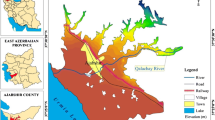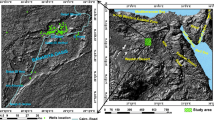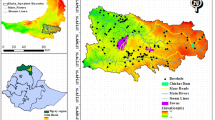Abstract
In this paper, two methods of mapping and assessment of the intrinsic vulnerability in porous media were applied to an urban case study relevant to illustrate the specificities and difficulties of African megacities concerning the management of the quality of the drinking water supply from groundwater. GOD and DRASTIC models have been used to map the shallow Mio-Plio-Quaternary aquifer vulnerability to pollution in the Tongo-Bassa watershed (Douala, Cameroon). Using GOD model, the results showed only one vulnerability class, the moderate one, extending all over the basin whatever the season. According to DRASTIC model, 25% (15%) of the basin has a moderate class of groundwater vulnerability to contamination, 5% (9%) has a very high vulnerability and 70% (76%) exhibit high vulnerability to contamination in dry (humid) season. There is an increase in high vulnerability zones in the rainy season, while in dry season, moderate vulnerable zones are observed. Vulnerability classes and a selection of chemical elements indicating human pollution are compared. Groundwater with high electrical conductivity corresponds mainly to high vulnerable class, while NO3− distribution does not coincide with the intrinsic vulnerability mapping. This raises the concept of pollution legacy as current nitrate load in some megacities is related to the history of urban development and human practices and not to present time conditions. The paper ends with clear recommendations to align land uses, landscape and groundwater protection in order to improve the quality of the drinking water supply for urban populations.






Similar content being viewed by others
Data Availability
The data will be made available by the authors upon on request.
References
Akenji VN, Ako Ako A, Akoachere RA, Takahiro H (2015) DRASTIC-GIS model for assessing vulnerability to pollution of the phreatic aquiferous formations in Douala–Cameroon. J African Earth Sci 102:180–190. https://doi.org/10.1016/j.jafrearsci.2014.11.001
Aller L, Bennett T, Lehr J et al (1987) DRASTIC: A standardised system for evaluating ground water pollution potential using hydrogeologic settings. National Water Well Association, Dublin, OH and Environmental Protection Agency, Ada, OK, EPA-600/2-87-035
Berkhoff K (2007) Groundwater vulnerability assessment to assist the measurement planning of the water framework directive—a practical approach with stakeholders. Hydrol Earth Syst Sci Discuss 4:1133–1151
Bastaraud A, Perthame E, Rakotondramanga J-M, Mahazosaotra J, Ravaonindrina N, Jambou R (2020) The impact of rainfall on drinking water quality in Antananarivo, Madagascar. PLoS ONE 15(6): e0218698. https://doi.org/10.1371/journal.pone.0218698
Chilton J (2006) Assessment of aquifer pollution vulnerability and susceptibility to the impacts of abstraction. In: Schmoll O, Howard G, Chilton J, Chorus I (eds) World Health Organization, Protecting groundwater for health: managing the quality of drinking-water sources. IWA Publishing, London
Daly D, Drew D (1999) Irish methodologies for karst aquifer protection. In: Beck B (ed) Hydrogeology and engineering geology of sinkholes and karst. Balkema, Rotterdam, pp 267–272
El Baba M, Kayastha P, Huysmans M, De Smedt F (2020) Groundwater vulnerability and nitrate contamination assessment and mapping using DRASTIC and geostatistical analysis. Water 12(7):2022. https://doi.org/10.3390/w12072022
Erostate M, Huneau F, Garel E, Lehmann MF, Kuhn T, Aquilina L, Vergnaud-Ayraud V, Labasque T, Santoni S, Robert S, Provitolo D, Pasqualini V (2018) Delayed nitrate dispersion within a coastal aquifer provides constraints on land-use evolution and nitrate contamination in the past. Sci Total Environ 644:928–940. https://doi.org/10.1016/j.scitotenv.2018.06.375
Fannakh A (2022) Farsang, A (2022) DRASTIC, GOD, and SI approaches for assessing groundwater vulnerability to pollution: a review. Environ Sci Eur 34:77. https://doi.org/10.1186/s12302-022-00646-8
Fantong WY, Fouepe AT, Ketchemen-Tandia B, Kuitcha D, Ndjama J, Fouepe TA, Takem GE, Issa WMJ, Bopda Djomou SL, Ako AA, Nkeng GE, Kusakabe M, Ohba T (2016) Variation of hydrogeochemical characteristics of water in surface flows, shallow wells and boreholes in the coastal city of Douala (Cameroon). Hydrol Sci J. https://doi.org/10.1080/0262666720161173789
Foster SSD (1987) Fundamental concepts in aquifer vulnerability, pollution risk and protection strategy, In Gogu RC, Dassargues A (2000) Current trends and future challenges in groundwater vulnerability assessment using overlay and index methods. Environ Geol 39(6):549–559
Foster S, Eichholz M, Nlend B, Gathu J (2020) Securing the critical role of groundwater for the resilient water-supply of urban Africa. Water Policy 2020:wp2020177. https://doi.org/10.2166/wp.2020.177
Gheisari N (2017) Groundwater vulnerability assessment using a GIS-based modified DRASTIC model in agricultural areas. Thesis, University of Ottawa, p 100
Healy RW, Cook PG (2002) Using groundwater levels to estimate recharge. Hydrogeol, J 10(91):109
Holman IP, Whelan MJ, Howden NJK, Bellamy PH, Willby NJ, Rivas-Casado M, McConvey P (2008) Phosphorus in groundwater—an overlooked contributor to eutrophication? Hydrol Process 22(26):5121–5127. https://doi.org/10.1002/hyp.7198
INSC (2010) Etude préliminaire sur l’économie locale de la ville de Douala, (In French). https://www.statistics-cameroonorg/newsphp?id=100
INSAE (2016) Principaux indicateurs socio démographiques et économiques (RGPH-4, 2013).
Jaunat J, Garel E, Huneau F, Erostate M, Santoni S, Robert S, Fox D, Pasqualini V (2018) Combinations of geoenvironmental data underline coastal aquifer anthropogenic nitrate legacy through groundwater vulnerability mapping methods. Sci Total Environ. https://doi.org/10.1016/j.scitotenv.2018.12.249
Ketchemen-Tandia B (2011) Déterminants hydrogéologiques de la complexité dusystème aquifère du bassin sédimentaire de Douala (Cameroun). University of Cheick Anta Diop, Thesis diss (in French), p 211
Ketchemen-Tandia B, Ngo Boum-Nkot S, Ebondji SR, Nlend BY, Emvoutou H, Nzegue O (2017) Factors influencing the shallow groundwater quality in four districts with different characteristics in urban area (Douala, Cameroon). J Geosci Environ Protect 5:99–120. https://doi.org/10.4236/gep.2017.58010
Kezebou F (2020) Evaluation et cartographie de la vulnérabilité de la nappe superficielle du bassin versant de la rivière Tongo Bassa (Douala-Cameroun). Msc thesis, University of Douala, p 59
Kopa NKA, Likeng HDJ, Nono A (2012) Hydrodynamique et qualité des eaux souterraines dans le bassin sédimentaire de Douala (Cameroun): Cas des aquifères sur formations quaternaires et tertiaires. Int J Biol Chem Sci 6(4):1874–1894
Lerner D, Harris R (2009) The relationship between land use and groundwater resources and quality. Land Use Policy 26:S265–S273. https://doi.org/10.1016/j.landusepol.2009.09.005
Lodwik WA, Monson W, Svoboda L (1990) Attribute error and sensitivity analysis of maps operation in geographical information systems–suitability analysis. Int J Geograph Inform Syst 4(1990):413–428
Manga CS (2008) Stratigraphy, structure and prospectivity of the Southern onshore Douala Basin, Cameroon- Central Africa. Africa Geosci Rev 1:13–37
Michael JF, Thomas ER, Michael GR, Dennis RH (2005) Assessing groundwater vulnerability to contamination: providing scientifically defensible information for decision makers. US geological survey circular 1224, US Department of the Interior, US Geological Survey. USGS Publishing Network
Napolitano P, Fabbri AG (1996) Single parameter sensitivity analysis for aquifer vulnerability assessment using DRASTIC and SINTACS. In: Proceedings of the 2nd HydroGIS Conference, vol 235. IAHS Publication, Wallingford, pp 559–566
Ndomè Effoudou-Priso E (2010) Minéralogie, Géochimie et Applications Géotechniques des produits d’altération sur roches sédimentaires de Douala. Thèse de Doctorat ; Univ. Yaoundé 1. Faculté des Sciences, p 212
Ngo Boum-Nkot S, Ketchemen-Tandia B, Ndje Y, Emvoutou H, Ebonji CR, Huneau F (2015) Origin of mineralization of groundwater in the Bassa watershed (Douala-Cameroon). J Hydrogeol Hydrol Eng 4:1–9
Nguene FR, Tamfu S, Loule JP, Ngassa C (1992) Paleoenvironment of the Douala and Kribi/Campo sub basins in Cameroon West Africa. Géologie Africaine: coll, Libreville, Recueil des communic, 6–8 May 1991; ISSNJ 010181- 0901-ISBN2-901026- 34,6.
Nlend B, Celle-Jeanton H, Huneau F, Garel E, Ngo Boum-Nkot S (2021) Etame J (2020) Shallow urban aquifers under hyper-recharge equatorial conditions and strong anthropogenic constrains, Implications in terms of groundwater resources potential and integrated water resources management strategies. Sci Total Environ 757:143887. https://doi.org/10.1016/j.scitotenv.2020.143887
Nlend B, Celle-Jeanton H, Huneau F, Ketchemen-Tandia B, Fantong WY, Ngo Boum-Nkot S, Etame J (2018) The impact of urban development on aquifers in large coastal cities of West Africa: present status and future challenges. Land Use Policy 75:352–363. https://doi.org/10.1016/j.landusepol.2018.03.007http://www,sciencedirect,com/science/article/pii/S026483771830125X
Ouedraogo I, Defourny P, Vanclooster M (2016) Mapping the groundwater vulnerability for pollution at the pan African scale. Sci Total Environ 544:939–953
Saghir J, Santoro J (2018) Urbanization in Sub-Saharan Africa. Center for Strategic & International Studies Report, Washington, DC, USA www.csis.org
Rauf LF, Ali SS, Al-Ansari N (2022) Groundwater vulnerability of Halabja-Khurmal sub-basin using modified DRASTIC method. Water Air Soil Pollut 233:440. https://doi.org/10.1007/s11270-022-05903-3
Regnoult JM (1986) Synthèse géologigue du Cameroon. Ministère des Mines et Energie, Yaounde, p 119 (in French)
Segalen P (1967) Les sols et géomorphologie du Cameroun. Cahier ORSTOM, sér, Péd, Vol V, n°2 pp 137–180
Shrestha S, Semkuyu DJ, Pandey VP (2016) Assessment of groundwater vulnerability and risk to pollution in Kathmandu Valley, Nepal. Sci Total Environ 556:23–35
Van Stempvoort D, Ewert L, Wassenaar L (1993) Aquifer vulnerability index: a GIS compatible method for groundwater vulnerability mapping. Canadian Water Resour J 18(1)
Takem GE, Kuitcha D, Ako AA, Mafany GT, Takounjou-Fouepe A, Ndjama J, Ntchancho R, Ateba BH, Chandrasekharam D, Ayonghe SN (2010) Acidification of shallow groundwater in the unconfined sandy aquifer of the city of Douala, Cameroon, Western Africa: implications for groundwater quality and use. Environ Earth Sci. https://doi.org/10.1007/s12665-015-4681-3
Vrba J, Zoporozec A (1994) Guidebook on mapping groundwater vulnerability. IAH Int Contrib Hydrogeol 16:131 (Hannover7 Heise)
WHO (2011) Guidelines for drinking water quality, 4th edn. World Health Organization, Geneva, Switzerland
Wirmvem MJ, Ohba T, Anye Nche L, Tchakam Kamtchueng B, Kongnso WE, Mimba ME, Bafon TG, Yaguchi M, Takem GE, Fantong WY, Ako AA (2017) Effect of diffuse recharge and wastewater on groundwater contamination in Douala Cameroon. Environ Earth Sci 76:354. https://doi.org/10.1007/s12665-017-6692-8
Yan B, Xiao C, Liang X et al (2016) Impacts of urban land use on nitrate contamination in groundwater, Jilin City. Arab J Geosci 9:105. https://doi.org/10.1007/s12517-015-2052-8
Author information
Authors and Affiliations
Contributions
Suzanne Ngo Boum-Nkot: project administration, funding acquisition, methodology, software, formal analysis, validation, writing—original draft. Bertil Nlend: sampling, data acquisition, methodology, investigation, formal analysis, writing—original draft. Frederic Huneau: methodology, validation, writing—original draft. Fabiola Kezebou: sampling, software, methodology. Bernard Gwodog: sampling, software, data acquisition.
Corresponding author
Ethics declarations
Conflict of interest
The authors declare no competing interests.
Additional information
Responsible Editor: Amjad Kallel
Supplementary information
ESM 1
(DOCX 384 kb)
Rights and permissions
Springer Nature or its licensor (e.g. a society or other partner) holds exclusive rights to this article under a publishing agreement with the author(s) or other rightsholder(s); author self-archiving of the accepted manuscript version of this article is solely governed by the terms of such publishing agreement and applicable law.
About this article
Cite this article
Boum-Nkot, S.N., Nlend, B., Huneau, F. et al. Groundwater vulnerability mapping of hyper-humid urban aquifers for an improved water management in African megacities, opportunities and limitations in the case of Douala (Cameroon). Arab J Geosci 17, 77 (2024). https://doi.org/10.1007/s12517-024-11885-9
Received:
Accepted:
Published:
DOI: https://doi.org/10.1007/s12517-024-11885-9




